初中英语作文教案(附反思)
初二期中英语作文指导教案
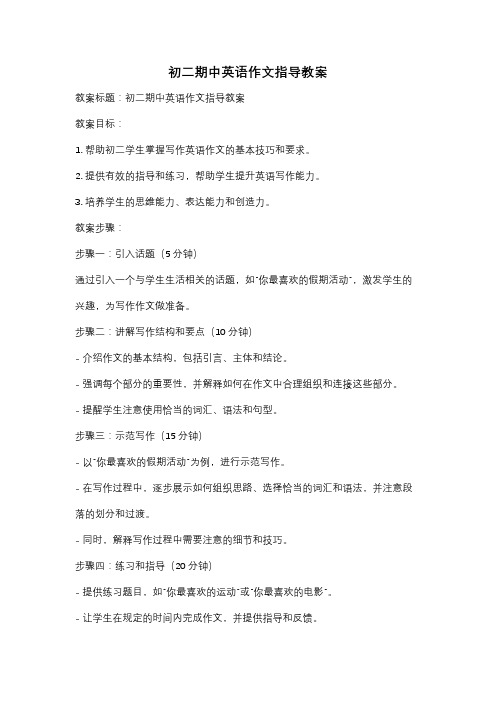
初二期中英语作文指导教案教案标题:初二期中英语作文指导教案教案目标:1. 帮助初二学生掌握写作英语作文的基本技巧和要求。
2. 提供有效的指导和练习,帮助学生提升英语写作能力。
3. 培养学生的思维能力、表达能力和创造力。
教案步骤:步骤一:引入话题(5分钟)通过引入一个与学生生活相关的话题,如"你最喜欢的假期活动",激发学生的兴趣,为写作作文做准备。
步骤二:讲解写作结构和要点(10分钟)- 介绍作文的基本结构,包括引言、主体和结论。
- 强调每个部分的重要性,并解释如何在作文中合理组织和连接这些部分。
- 提醒学生注意使用恰当的词汇、语法和句型。
步骤三:示范写作(15分钟)- 以"你最喜欢的假期活动"为例,进行示范写作。
- 在写作过程中,逐步展示如何组织思路、选择恰当的词汇和语法,并注意段落的划分和过渡。
- 同时,解释写作过程中需要注意的细节和技巧。
步骤四:练习和指导(20分钟)- 提供练习题目,如"你最喜欢的运动"或"你最喜欢的电影"。
- 让学生在规定的时间内完成作文,并提供指导和反馈。
- 鼓励学生互相交流和修改作文,以提高写作质量。
步骤五:总结和评价(10分钟)- 回顾本节课所学的写作技巧和要点。
- 对学生的作文进行评价,指出优点和需要改进的地方。
- 鼓励学生继续努力,并提供一些建议和资源,以帮助他们进一步提升写作能力。
教案扩展:1. 可以引入更多的写作话题,如"你的梦想"、"你的家乡"等,以帮助学生拓展写作主题和词汇。
2. 可以组织学生进行写作比赛或小组讨论,激发学生的学习兴趣和积极性。
3. 可以利用多媒体资源,如视频、图片等,帮助学生更好地理解和表达写作主题。
教案评估:通过学生的参与度、作文质量和课堂反馈等方面,评估学生对写作技巧和要求的掌握情况。
同时,也评估教案的有效性和学生的学习成果。
初中书信英语作文讲解教案
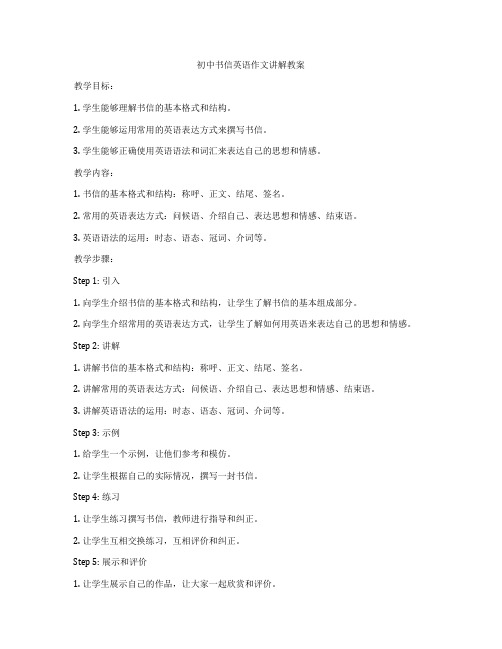
初中书信英语作文讲解教案教学目标:1. 学生能够理解书信的基本格式和结构。
2. 学生能够运用常用的英语表达方式来撰写书信。
3. 学生能够正确使用英语语法和词汇来表达自己的思想和情感。
教学内容:1. 书信的基本格式和结构:称呼、正文、结尾、签名。
2. 常用的英语表达方式:问候语、介绍自己、表达思想和情感、结束语。
3. 英语语法的运用:时态、语态、冠词、介词等。
教学步骤:Step 1: 引入1. 向学生介绍书信的基本格式和结构,让学生了解书信的基本组成部分。
2. 向学生介绍常用的英语表达方式,让学生了解如何用英语来表达自己的思想和情感。
Step 2: 讲解1. 讲解书信的基本格式和结构:称呼、正文、结尾、签名。
2. 讲解常用的英语表达方式:问候语、介绍自己、表达思想和情感、结束语。
3. 讲解英语语法的运用:时态、语态、冠词、介词等。
Step 3: 示例1. 给学生一个示例,让他们参考和模仿。
2. 让学生根据自己的实际情况,撰写一封书信。
Step 4: 练习1. 让学生练习撰写书信,教师进行指导和纠正。
2. 让学生互相交换练习,互相评价和纠正。
Step 5: 展示和评价1. 让学生展示自己的作品,让大家一起欣赏和评价。
2. 教师对学生的作品进行评价,给予肯定和建议。
教学评价:1. 学生能够正确掌握书信的基本格式和结构。
2. 学生能够灵活运用常用的英语表达方式来撰写书信。
3. 学生能够正确使用英语语法和词汇来表达自己的思想和情感。
教学反思:本节课通过讲解和练习,让学生了解了书信的基本格式和结构,以及常用的英语表达方式。
学生在撰写书信的过程中,能够灵活运用所学的英语语法和词汇来表达自己的思想和情感。
通过展示和评价,学生能够更好地理解和掌握书信的写作技巧。
但在教学过程中,要注意引导学生正确使用英语语法和词汇,避免出现错误。
同时,也要鼓励学生发挥自己的想象力和创造力,使书信更具个性化和独特性。
初中英语作文教案

初中英语作文教案一、教学目标:1.能够掌握基本的英语作文写作技巧;2.能够运用所学知识,写出简单、连贯、有逻辑的英语作文;3.培养学生的英语写作兴趣,提高写作能力。
二、教学重点:1.培养学生的写作兴趣;2.教授基本的英语写作技巧;3.激发学生的写作创造力。
三、教学难点:1.如何培养学生的写作兴趣;2.如何激发学生的写作创造力。
四、教学内容:1.教师引导学生阅读范文,分析范文结构、语言表达等;2.教师讲解英语作文写作技巧,如句型搭配、词汇运用等;3.教师指导学生进行写作训练,如写作练习、写作指导等;4.教师布置作业,让学生在家继续练习写作。
五、教学过程:1.教师引导学生阅读范文,分析范文结构、语言表达等,激发学生的写作兴趣;2.教师讲解英语作文写作技巧,如句型搭配、词汇运用等,提高学生的写作能力;3.教师指导学生进行写作训练,如写作练习、写作指导等,培养学生的写作技能;4.教师布置作业,让学生在家继续练习写作,巩固所学知识。
六、教学方法:1.导入法,通过引导学生阅读范文,激发学生的写作兴趣;2.讲授法,通过讲解英语作文写作技巧,提高学生的写作能力;3.示范法,通过指导学生进行写作训练,培养学生的写作技能;4.作业法,通过布置作业,巩固所学知识,提高学生的写作水平。
七、教学手段:1.多媒体课件,用于展示范文、写作技巧等;2.教学实物,如英语作文书籍、写作范文等;3.黑板报,用于记录重点、难点内容,帮助学生复习。
八、教学检查与评价:1.教师在课堂上进行实时检查,发现学生写作中的问题并及时纠正;2.教师在课后进行作业批改,对学生的写作进行评价,指导学生改进。
九、教学反思:1.教师要及时调整教学方法,根据学生的实际情况进行针对性教学;2.教师要注重培养学生的写作兴趣,激发学生的写作热情;3.教师要关注学生的写作能力提高情况,及时进行评价和指导。
初中英语作文教案到此结束,希望本教案能够帮助到广大英语教师,提高学生的写作水平。
初中英语作文教案(附反思)
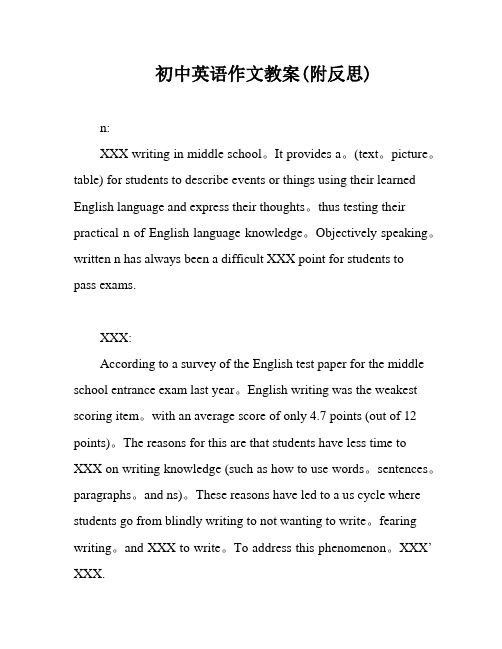
初中英语作文教案(附反思)n:XXX writing in middle school。
It provides a。
(text。
picture。
table) for students to describe events or things using their learned English language and express their thoughts。
thus testing their practical n of English language knowledge。
Objectively speaking。
written n has always been a difficult XXX point for students to pass exams.XXX:According to a survey of the English test paper for the middle school entrance exam last year。
English writing was the weakest scoring item。
with an average score of only 4.7 points (out of 12 points)。
The reasons for this are that students have less time to XXX on writing knowledge (such as how to use words。
sentences。
paragraphs。
and ns)。
These reasons have led to a us cycle where students go from blindly writing to not wanting to write。
fearing writing。
and XXX to write。
七年级上册英语作文教案设计及反思
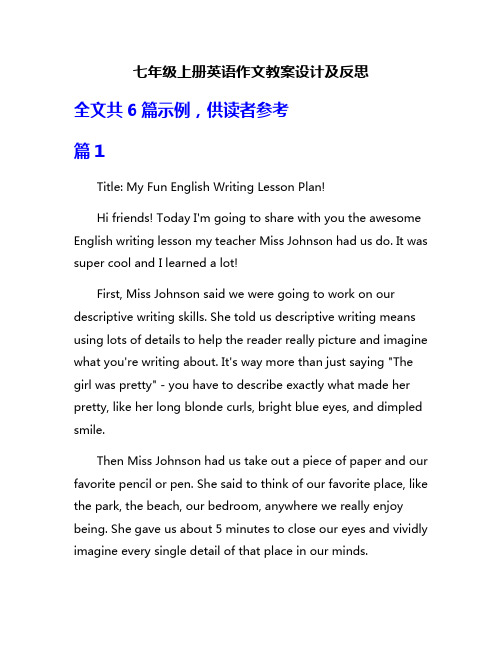
七年级上册英语作文教案设计及反思全文共6篇示例,供读者参考篇1Title: My Fun English Writing Lesson Plan!Hi friends! Today I'm going to share with you the awesome English writing lesson my teacher Miss Johnson had us do. It was super cool and I learned a lot!First, Miss Johnson said we were going to work on our descriptive writing skills. She told us descriptive writing means using lots of details to help the reader really picture and imagine what you're writing about. It's way more than just saying "The girl was pretty" - you have to describe exactly what made her pretty, like her long blonde curls, bright blue eyes, and dimpled smile.Then Miss Johnson had us take out a piece of paper and our favorite pencil or pen. She said to think of our favorite place, like the park, the beach, our bedroom, anywhere we really enjoy being. She gave us about 5 minutes to close our eyes and vividly imagine every single detail of that place in our minds.After the 5 minutes were up, Miss Johnson said "Okay writers, put your pencils to your papers and start describing your favorite place in as much detail as possible. Don't hold back - I want to see descriptive sentences that really make me feel like I'm right there with you."We all started furiously writing, trying to include as many descriptive details as we could. I wrote all about my favorite spot, which is the treehouse in my backyard. I described the rough wooden planks, the cool shadiness inside, the little circle window that looks out over the yard. I included details about the musty smell, the scratchy rope ladder, and the squirrel family that sometimes scampers across the roof. It was kind of hard at first, but once I got going the words just flowed out of my pencil!After about 15 minutes of writing, Miss Johnson called time. She had us get into groups of 4 or 5 and take turns reading our descriptions out loud. It was amazing hearing all the different places my friends wrote about - the swing set at the park, a cozy reading nook, even the neighborhood pool! Their descriptions were so vivid and painted such a clear picture in my mind.When we finished sharing in our groups, Miss Johnson brought us back together. She called on a few volunteers to readtheir favorites from their group. Then she pointed out some of the strongest descriptive phrases and sentences she heard, like:"Silky white sand oozed between my toes""Sunbeams danced along the rippling waves""The tangy aroma of chlorine assaulted my nostrils"Miss Johnson said using vivid adjectives, figurative language like personification, and specific details about sights, smells, sounds, and textures really make descriptive writing jump off the page.Then it was time for the best part - revising and improving our descriptions! Miss Johnson let us pick partners and revise each other's work. My partner Jake and I went through each other's paragraphs, circling our favorite descriptive phrases and suggesting new ones. Like for my treehouse description, Jake thought I should add something about rustling leaves and birds chirping to engage more senses.After we revised, Miss Johnson had Jakob and I get up and read our updated descriptions to the class. I was a little nervous, but it was so satisfying to share my polished work! The whole class gave us a big round of applause at the end.As we were packing up, Miss Johnson reminded us that descriptive writing takes a lot of practice, but it's an important skill. "The more you exercise your descriptive writing muscles, the easier it will become to craft writing that allows your readers to vividly picture your words," she told us. She said we should try keeping a daily "descriptive writing journal" where we write a short paragraph describing something we saw, heard, smelled, etc. that day.Overall, it was such a fun and engaging lesson! I really feel like I have a much better grasp on using strong descriptive details in my writing now. Shoutout to Miss Johnson for planning such an awesome activity - that woman is a descriptive writing queen! I can't wait for our next lesson.That's all for my behind-the-scenes look at our 7th grade descriptive writing lesson. Let me know if you have any other questions! Writing is hard work but it's so rewarding. Keep working on those descriptive skills and you'll be novelists and poets in no time!篇2My English Teacher's Awesome Lesson PlanLast week in English class, Mrs. Peterson had a really cool lesson planned for us! She was teaching us how to write a descriptive essay about our favorite place. I was super excited because I love writing and I couldn't wait to describe my grandma's house which is my favorite place ever.First things first, Mrs. Peterson put some pictures up on the board of different places like forests, beaches, playgrounds and cities. She asked us to look closely at the details in the pictures and make a list of adjectives we could use to describe them. I wrote down words like "green", "sandy", "colorful" and "crowded". Then she had us get into groups and share the words we listed. My group had some great vocabulary like "serene", "lively" and "breathtaking".Next up, Mrs. Peterson modeled how to write an introductory paragraph for a descriptive essay. She started with a "hook" sentence to grab the reader's attention. Then she introduced the main topic, which was describing her childhood hometown. She read her intro paragraph out loud and it made me really want to visit her hometown!After that, it was our turn to start drafting our essays. Mrs. Peterson reminded us to divide our body paragraphs by describing different senses - sight, sound, smell, taste, and touch.She also encouraged us to use figurative language like similes and metaphors to make our descriptions more vivid and engaging.While we were writing, Mrs. Peterson circulated around the room, checking on our progress and offering feedback. She reminded Ramon to vary his sentence structure instead of starting every sentence with "It was..." And she complimented Jasmine on her creative metaphor comparing her grandmother's living room to a cozy bird's nest.With about 15 minutes left in class, a few volunteers read their intro paragraphs aloud. I was really impressed by how different yet descriptive each one was! Mrs. Peterson praised us for our hard work and reminded us to revise and edit our drafts for homework.Reflecting on My LearningOverall, I think Mrs. Peterson's lesson was super effective in teaching us the key elements of a descriptive essay. By activating our prior knowledge with the picture prompts and vocabulary brainstorming, she got us ready to tackle the writing process. Her modeling and examples were really clear too.The thing I liked best about this lesson was getting to write about a place that's meaningful to me, my grandma's house. Usually we have to write essays on random topics, but this one allowed me to tap into my personal experiences and happy memories. It definitely made the writing more enjoyable and rewarding.If I could give Mrs. Peterson one suggestion, it would be to allow more time for drafting. Even though we had to finish for homework, I felt a little rushed trying to cram all my descriptions into one class period. Maybe we could have worked on it over two days, using the first day for planning and drafting theintro/body, then the next day for revising and writing the conclusion.But honestly, I'm really proud of the descriptive essay I wrote and I can't wait to get it back with Mrs. Peterson's feedback. Learning how to "show not tell" through vivid details and figurative language will definitely help make me a stronger writer. Overall it was an awesome, engaging lesson that I won't forget anytime soon!篇3My Super Cool English Lesson Plan!Hi everyone! I'm going to tell you all about the awesome English lesson I planned for my 7th grade class. We're using the first book of the year and I had to make it really fun and easy to understand. Let me walk you through it!First up, I started with a fun warm-up activity. I asked the class "What's your favorite food?" and had them share with a partner. Then I picked a few students to share their answers like "I love pizza!" or "Cookies are the best!" This got them talking and thinking in English right away.Next, I introduced the new vocabulary words we'd be learning that day. Instead of just writing them on the board, I made it into a guessing game! I acted out each word like "hungry" by rubbing my belly. The students had to raise their hands and guess the meaning. We all ended up laughing a lot which made it easier to remember the new words.Then it was time for the reading passage. I picked a really cool article about foods from around the world. Before we read, I had students make predictions about what the passage could be about just from the title. I also pre-taught a few harder vocabulary words by having students use them in sample sentences.While reading, we stopped every few paragraphs to discuss what we had learned so far. I asked comprehension questions like "What food from India was mentioned?" Students had to go back and find evidence from the text. Reading is way more fun when you get to discuss and debate the ideas!After reading, I split the class into small groups. Each group had to make a poster advertisement for their favorite food from the passage. They had to be creative by drawing pictures and using persuasive language like "The most delicious food you'll ever taste!" Then groups presented their awesome posters to the rest of the class.Finally for homework, students had to write a short paragraph describing their favorite food using some of the new vocabulary we learned. I encouraged them to share their paragraphs with their families to practice reading out loud.Overall, I think my lesson went super well! The students stayed engaged with all the games, discussions, and group work.I made sure to incorporate all four skills: reading, writing, speaking, and listening. Mixing up the activities kept things from getting boring.One thing I would change is spending more timepre-teaching vocabulary. There were a few words like "cuisine"that still tripped some students up during the reading. Next time, I'll make sure everyone is really confident with the tough words first.I also ran out of time for students to share their homework paragraphs. Pacing was a little difficult since great discussions took up more time than I expected. But that's okay, just something to remember for future classes.Being an English teacher is hard work but so rewarding! I love developing creative lesson plans to make learning come alive. My students had an amazing time, and they're well on their way to becoming fluent English speakers. Maybe I'll become a teacher for real one day! But for now, I'm just killing it in 7th grade.篇4Title: Making English Fun and Easy!Hey guys! Josh here. Today I want to tell you all about how I made learning English super fun this year. You see, I just finished the 7th grade and my English teacher Mrs. Park did something really cool. Instead of just following the textbook boringly like most teachers, she made her own special lesson plans to makeEnglish class way more interesting and helpful. Let me explain how she did it!First up, Mrs. Park looked through the whole 7th grade English textbook at the start of the year to get an idea of what topics and skills we'd be covering. She noticed we'd be learning about things like describing people and places, talking about daily routines, shopping dialogues, and so on. Sounds pretty dry, right? But then she had a great idea!For篇5My Teacher Showed Us How to Write Cool Stories!Hi friends! Today I'm going to tell you about the awesome English writing lessons we had in 7th grade. Mrs. Johnson is our English teacher and she is really fun and nice. At the start of the school year, she said we were going to learn how to write excellent stories and essays. I was super excited because I love creative writing!For the first few weeks, Mrs. Johnson taught us about the different elements that go into a good story. She said every narrative needs interesting characters, a clear setting, a problemor conflict, a plot with different events, and a resolution at the end. She read us some examples of great short stories and had us identify all those story elements. It was kind of like being a detective!Then Mrs. Johnson showed us examples of descriptive writing and how authors use vivid adjectives and details to help the reader picture the characters, settings, and events vividly in their minds. She had us practice writing descriptive paragraphs about our favorite places, people, foods, etc. I wrote a super detailed paragraph about my dog Rufus and how fuzzy, playful and slobbery he is. It was really fun!Next up was learning how to develop a plot and make our stories exciting and unpredictable. Mrs. Johnson taught us some techniques like foreshadowing, cliffhangers, and dramatic irony to build suspense and keep readers hooked. We had to map out the major events and conflicts that would drive our stories forward. I came up with a plot about a kid who finds a magic coin that grants wishes, but it starts causing crazy mayhem!Once we had prewriting outlines for our stories, we started drafting them over several weeks. Mrs. Johnson gave us checklists and reminders for including all the story elements, adding lots of descriptive details, using dialogue correctly,varying our sentence structure, and more. We did multiple drafts, peer editing sessions, and revisions based on Mrs. Johnson's feedback.Finally, we had completed our original short stories! Mrs. Johnson combined everyone's into an awesome class anthology book. We had a special "book launch" party and got to read excerpts of our stories aloud. My magic coin story was a big hit - my classmates thought the wacky things the coin made happen were hilarious. I was so proud of my work!Writing my first long story was challenging but also incredibly rewarding. Thanks to Mrs. Johnson's excellent lessons, I now understand plot structure way better and how to craft an engaging narrative with vivid details. I feel much more confident about writing strong stories and essays in the future.Our 7th grade writing unit was one of my favorite things we did all year! Mrs. Johnson made the whole process really fun and creative. Not only did I become a better writer, but I got to unleash my imagination and write about something wild like a magic coin causing chaos. I can't wait to take more creative writing in the future and write longer stories and books someday.A huge thanks to Mrs. Johnson for being such an inspiring teacher!篇6English Lesson Plan and ReflectionBy: A 4th GraderHiya! My name is Jamie and I'm 9 years old. I love English class and my teacher Mrs. Andrews always has us do really fun activities. Today she asked us to design an English lesson plan for 7th graders! I thought that sounded like a super cool project.First, we had to pick what unit from the 7th grade textbook we wanted to make our lesson on. I picked Unit 3 because the topic is "Exploring Nature" and I really like outdoor stuff like hiking, camping, and looking for cool bugs and rocks. The unit has readings about national parks, environmentalism, and there's even a poem about a waterfall!Lesson Plan DesignFor the warmup, I would have the 7th graders go around the room and name their favorite outdoor place they've visited, like a beach, forest, or mountain. Then we'd discuss what makes those natural spots so special and important to protect.The main activity would be splittin' the class into small groups. Each group gets assigned a different national park fromthe reading. Their job is to research that park online and make a promotional poster or brochure advertising it. The poster has to have:Eye-catching pictures or drawings of the parkBasic facts like location, size, famous landmarksReasons why someone should visit (pretty scenery, outdoor activities, wildlife, etc)any important environmental issues affecting the parkOnce the groups finish their posters, we'd hang them up around the room. Then two members from each group would present their poster to the rest of the class, trying to get us all excited to vacation there!For extra creativity, the groups could also make up a fun slogan or jingle for their park. And we'd have a classroom vote at the end for which park seems the coolest based on the posters.For homework, students would write a one-page journal entry imagining they visited whichever national park looked most awesome to them. They'd describe what they did, what they saw, how the nature made them feel, etc. Bringing in that personal connection!I think making those posters and presentations would be a really engaging way for 7th graders to learn all about national parks—where they're located, their special features, environmental challenges they face, and why they're so vital to preserve. Much more fun than just reading a textbook!ReflectionAfter we designed our lesson plans, Mrs. Andrews had us reflect on some key things:How does this lesson align with the unit goals & academic standards?My national park poster lesson relates to the main unit goals of increasing appreciation for nature, learning about environmental conservation issues, and analyzing persuasive marketing like you'd see in travel brochures. It meets ELA standards for research, public speaking, and writing informative/explanatory texts.How could you differentiate instruction for different learners?For students who struggle with research and writing, they could just focus on making the poster visuals really powerful. Stronger writers could take the lead on the fact-gathering anddescriptions. For kinesthetic learners, we could take a walking tour around our poster gallery.What skills does this lesson develop?It develops research abilities, teamwork, creativity, persuasive writing/speaking, visual communication through posters/ads, and national park/environmentalism content knowledge.How could you integrate technology?Students could build digital posters and multimedia presentations using design software instead of justpaper/marker posters. We could take virtual video tours of some parks. Or maybe even video chat with a park ranger!What potential roadblocks might come up and how could you solve them?Some roadblocks could be students forgetting to cite their poster research, having troubles with group dynamics, running out of time to complete everything, or technical issues if using computers. Having clear rubrics, guidelines, and deadlines would help. I'd also model how to properly cite sources.Overall I'm really proud of my engaging national park poster lesson idea! It lets 7th graders take charge of their own learningabout this important environmental topic through a creative hands-on project. Thank you for reading my lesson plan and reflections!。
初中英语写作课教案及反思

初中英语写作课教案及反思作为一名英语教师,做好英语写作教案及课后反思是很有必要的,下面是店铺整理的初中英语写作课教案,希望能帮到大家!初中英语写作课教案篇一:课前准备一、背景知识介绍。
书面表达是写的一种途径,是英语交际的重要组成部分。
初中阶段对于英语写作的要求,实际上是“有指导的写作”(Guided Writing)。
它通过提供情景(文字、图画、表格),让学生用学过的英语语言来描述事物或事件并表达一定的思想,以此达成和检验对所学英语语言知识的实践应用能力。
客观地说,书面表达一直是我们英语教学的一个难点,也是学生应试的一个难点。
从去年对中考英语试卷的抽样调查情况来看,英语写作是得分最为薄弱的一个题项,平均分只有4.7分(满分为12分)。
究其原因,一是学生写作练习的时间少,二是教师平时缺乏对学生进行系统的写作知识的指导。
(比如,如何用词、句、组段、谋篇等)。
这些原因造成了学生从最初不会写盲目写到不愿写。
惧怕写,直至最后拒绝写的恶性循环。
针对这一现象,我在教学过程进行了一次如何提高学生写作能力的课堂实践。
教师旨在通过与学生谈论他们熟悉的话题“making friends”, 搜索学生头脑中有关朋友的消息,通过阅读两则e-pal广告,获取e-pals的一些信息,指导如何写e-mail ,从而达到给e-pals 写信的目的。
二、教学过程。
1.Warm-up活动:通过听一首英语歌:“The more we get together, the happier we’ll be.”目的是活跃气氛,为引出今天的话题做准备。
2.Revision ①使用大脑风暴法(brainstorm)让学生想出一些和friends 有关的单词短语和句子,目的是激活学生头脑中和写作话题make friends 相关的东西,如想法、概念、形象等酝酿写作的思路,供拟稿阶段(drafting stage)选择有写的价值和意义的东西时参考。
初中英语作文课教案
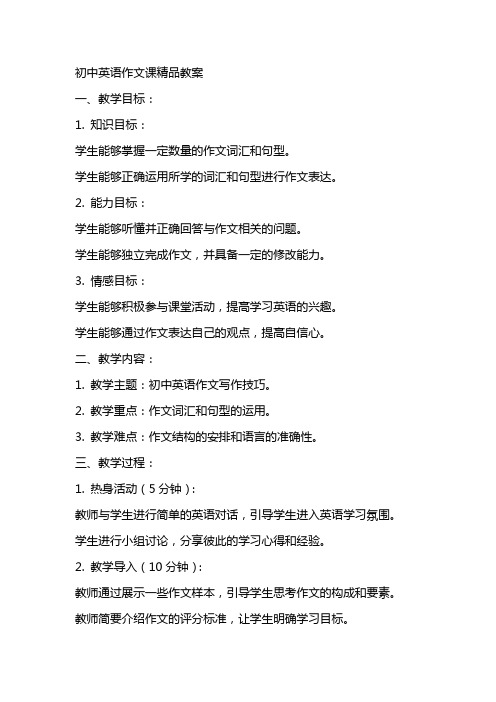
初中英语作文课精品教案一、教学目标:1. 知识目标:学生能够掌握一定数量的作文词汇和句型。
学生能够正确运用所学的词汇和句型进行作文表达。
2. 能力目标:学生能够听懂并正确回答与作文相关的问题。
学生能够独立完成作文,并具备一定的修改能力。
3. 情感目标:学生能够积极参与课堂活动,提高学习英语的兴趣。
学生能够通过作文表达自己的观点,提高自信心。
二、教学内容:1. 教学主题:初中英语作文写作技巧。
2. 教学重点:作文词汇和句型的运用。
3. 教学难点:作文结构的安排和语言的准确性。
三、教学过程:1. 热身活动(5分钟):教师与学生进行简单的英语对话,引导学生进入英语学习氛围。
学生进行小组讨论,分享彼此的学习心得和经验。
2. 教学导入(10分钟):教师通过展示一些作文样本,引导学生思考作文的构成和要素。
教师简要介绍作文的评分标准,让学生明确学习目标。
3. 教学主体(15分钟):教师讲解作文的基本结构,包括开头、和结尾。
教师举例说明作文中常用的词汇和句型,并让学生进行实际操作练习。
4. 小组活动(10分钟):学生分组进行讨论,共同完成一篇作文。
教师巡回指导,解答学生的问题,并给予鼓励和指导。
5. 总结与作业布置(5分钟):教师对本次课程进行总结,强调作文的重要性和学习方法。
学生完成一篇短文写作,作为课后作业。
四、教学评价:1. 学生作文的完成情况。
2. 学生对作文知识的掌握程度。
3. 学生对作文学习的兴趣和积极参与程度。
五、教学资源:1. 作文样本。
2. 作文词汇和句型资料。
3. 英语作文评分标准。
六、教学策略:1. 采用任务型教学法,通过小组活动和实际操作,提高学生的参与度和积极性。
2. 运用交际式教学法,引导学生进行英语对话,培养学生的口头表达能力和听力技能。
3. 运用情境教学法,创设真实的学习情境,提高学生的学习兴趣和主动性。
七、教学手段:1. 使用多媒体教学资源,如课件、视频和音频等,丰富教学内容,提高学生的学习兴趣。
初一作文教案反思模板范文

初一作文教案反思模板范文英文回答:Reflection Template for Junior High School Composition Lesson Plan。
1. What were the strengths of the lesson plan?Clear learning objectives and lesson structure.Engaging activities that actively involved students.Use of differentiated instruction to meet individual student needs.2. What were areas for improvement in the lesson plan?More time could have been allocated for student practice.Assessment strategies could have been more varied.The use of technology could have been integrated more effectively.3. How did the students respond to the lesson?Students were engaged and actively participated in the activities.Students demonstrated a good understanding of the concepts taught.Students provided positive feedback on the lesson.4. What changes would you make to the lesson plan if you were to teach it again?Allocate more time for student practice.Use more varied assessment strategies, such as peer review and self-reflection.Integrate technology more effectively, such as using online collaboration tools.中文回答:初一作文教案反思模板。
2024年初中英语教学案例(优秀8篇)

2024年初中英语教学案例(优秀8篇)初中英语教学案例篇一一、关注学生情感,创造民主、和谐的教学气氛。
学生只有对自己、对英语及其文化有积极的情态,才能保持英语学习的动力并取得成绩,刻板的情态,不仅会影响英语学习的效果,还会影响其它发展,情态是学好英语的重要因素,因此我努力创造宽松民主、和谐的教学空间,做到:1、尊重每个学生,积极鼓励他们在学习中的尝试,保护他们的自尊心和积极性。
2、把英语教学与情态有机地结合起来,创造各种合作学习的活动,促进学生互相学习,互相帮助,体验成就感,发展合作精神。
3、关注学习有困难的或性格内向的学习,尽可能地为他们创造语言的机会。
4、建立融洽、民主的师生交流渠道,经常和学生一起反思学习过程和学习效果,互相鼓励和帮助,做到教学相关。
二、面向全体学生,为学生全面发展和终身发展奠定基础。
1、创设各种情景,鼓励学生大胆地使用英语,对他们在学习过程中的失误和错误采取宽容的态度。
2、为学生提供自主学习和直接交流的机会,以及充分表现和自我发展的一个空间。
3、鼓励学生通过体验、实践、合作、探索等方式,发展听、说、读、写的综合能力。
4、创造条件让学生能够探究他们自己的一些问题,并自主解决问题。
三、加强对学生学习策略的指导,让他们在学习和适用的过程中逐步学会如何学习做到:1、积极创造条件,让学生参与到阶段性学习目标,以及实现目标的方法。
2、引导学生结合语境,采用推测、查阅和协调的方法进行学习。
3、引导学生在学习过程中,进行自我评价,并根据需要调整自己的学习目标和学习策略。
四、对学生进行有效的评价。
评价可以使学生认识自我,树立自信,有助于反思及调整自己的学习过程,评价或采用测验及非测验形式,平时重视形成性评价,对学生回答学习过程中的表现所改进的诚绩,及反映的情感、态度、策略某方面进行及时的评价,如有口头评价、等级评价、学生之间互相评价等方法,充分发觉学生的进步,鼓励学生自我反思,自我提高,测验以学生综合运用能力为目标,侧重于学生理解和获取信息,能力减少客观题,增加主观题,通过评价学生学会分析自己的成绩和不足,明确努力方向。
九年级英语教案及课后反思随笔5篇

九年级英语教案及课后反思随笔5篇九年级英语教案及课后反思1一、教学目标:1. 语言知识目标:1) 学习掌握下列词汇:fridge,low,somebody, translate, lock, earthquake,sudden, allof asudden,biscuit,cookie, instrument九年级英语教案及课后反思2学习目标1.重点单词:expression,discover,secret,grammar2重点短语:an English movie called Toy Story,fall in love with,as well,look up3重点句式:The teacher spoke so quicklythat I did not understand her most of the time.I was afraid to ask questionsbecause of my poor pronunciation.I can find the meaningof new words by looking them up in a dictionary.学习重点1.重点短语和句型2.学习英语的方法学习难点学习英语的方法自主学习一、预习课本P3新单词并背诵,完成下面的汉译英。
1.表达_________2.发现________3.秘诀_______4.语法______二、认真预习P3找出下列短语和句型。
1.一部叫做Toy Story的电影2.喜欢上3.也4.老师说得如此的快以至于我大多数时间都不明白。
5.因为我的发音很差,我害怕问问题。
6.我通过在字典里查询找到新单词的意思。
课堂导学Step 1情景导入Teacher:Wei Fen really likes English and sheis a student who is good at English but she didnt use to like English.Do you knowwhat has changed her?Lets read the passageto find the answer.环节说明:由Wei Fen英语成绩的变化为话题,引起学生的好奇,同时又引出要学的内容。
名师讲解初中英语作文教案
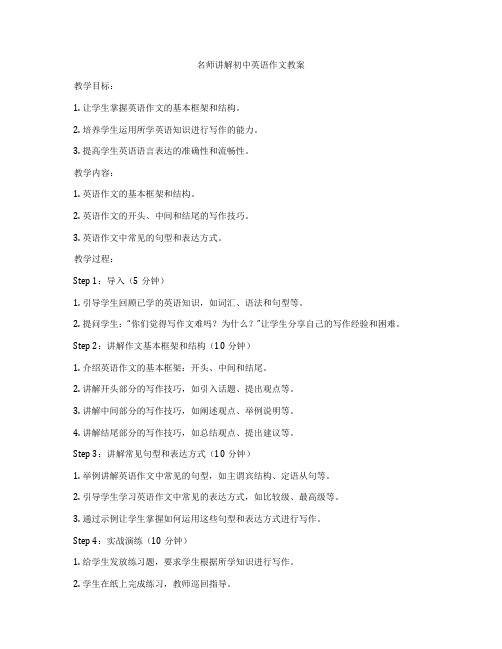
名师讲解初中英语作文教案教学目标:1. 让学生掌握英语作文的基本框架和结构。
2. 培养学生运用所学英语知识进行写作的能力。
3. 提高学生英语语言表达的准确性和流畅性。
教学内容:1. 英语作文的基本框架和结构。
2. 英语作文的开头、中间和结尾的写作技巧。
3. 英语作文中常见的句型和表达方式。
教学过程:Step 1:导入(5分钟)1. 引导学生回顾已学的英语知识,如词汇、语法和句型等。
2. 提问学生:“你们觉得写作文难吗?为什么?”让学生分享自己的写作经验和困难。
Step 2:讲解作文基本框架和结构(10分钟)1. 介绍英语作文的基本框架:开头、中间和结尾。
2. 讲解开头部分的写作技巧,如引入话题、提出观点等。
3. 讲解中间部分的写作技巧,如阐述观点、举例说明等。
4. 讲解结尾部分的写作技巧,如总结观点、提出建议等。
Step 3:讲解常见句型和表达方式(10分钟)1. 举例讲解英语作文中常见的句型,如主谓宾结构、定语从句等。
2. 引导学生学习英语作文中常见的表达方式,如比较级、最高级等。
3. 通过示例让学生掌握如何运用这些句型和表达方式进行写作。
Step 4:实战演练(10分钟)1. 给学生发放练习题,要求学生根据所学知识进行写作。
2. 学生在纸上完成练习,教师巡回指导。
3. 选取部分学生的作品进行点评和讲解。
Step 5:总结和作业布置(5分钟)1. 总结本节课所学的写作技巧和句型。
2. 布置作业:让学生根据所学知识,写一篇话题作文。
教学评价:1. 学生对英语作文基本框架和结构的掌握程度。
2. 学生对英语作文常见句型和表达方式的运用能力。
3. 学生写作的准确性和流畅性。
备注:本教案根据学生的实际情况和教学需求进行调整。
初中英语作文讲解专题教案
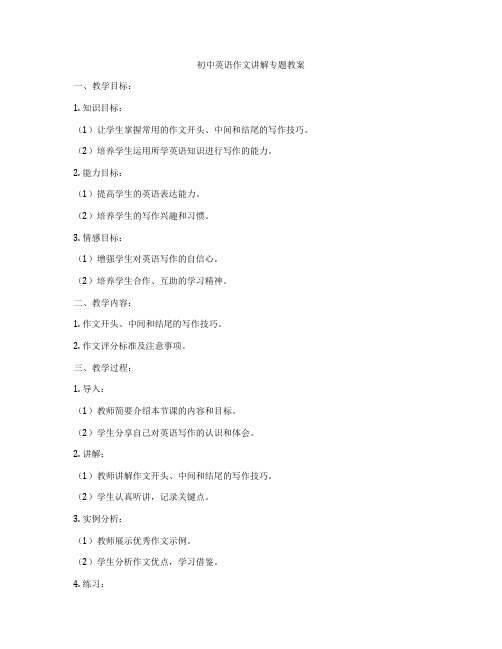
初中英语作文讲解专题教案一、教学目标:1. 知识目标:(1)让学生掌握常用的作文开头、中间和结尾的写作技巧。
(2)培养学生运用所学英语知识进行写作的能力。
2. 能力目标:(1)提高学生的英语表达能力。
(2)培养学生的写作兴趣和习惯。
3. 情感目标:(1)增强学生对英语写作的自信心。
(2)培养学生合作、互助的学习精神。
二、教学内容:1. 作文开头、中间和结尾的写作技巧。
2. 作文评分标准及注意事项。
三、教学过程:1. 导入:(1)教师简要介绍本节课的内容和目标。
(2)学生分享自己对英语写作的认识和体会。
2. 讲解:(1)教师讲解作文开头、中间和结尾的写作技巧。
(2)学生认真听讲,记录关键点。
3. 实例分析:(1)教师展示优秀作文示例。
(2)学生分析作文优点,学习借鉴。
4. 练习:(1)教师布置作文题目。
(2)学生现场作文,教师巡回指导。
5. 点评与讲解:(1)教师选取几篇学生作文进行点评。
(2)针对学生作文中的问题,进行讲解和指导。
6. 总结与布置作业:(1)教师总结本节课所学内容。
(2)布置课后作业,要求学生加强写作练习。
四、教学策略:1. 任务型教学法:通过设定具体写作任务,让学生在实践中学习、提高。
2. 合作学习法:鼓励学生互相评价、互相帮助,共同提高写作水平。
3. 激励性评价:注重激发学生的写作兴趣,鼓励学生自信心。
五、教学评价:1. 学生作文完成情况。
2. 学生对作文写作技巧的掌握程度。
3. 学生写作兴趣和自信心的提高。
六、教学资源:1. 优秀作文示例。
2. 作文评分标准及注意事项。
3. 教学课件、黑板等。
七、教学时间:1课时(45分钟)八、课后作业:1. 根据本节课所学,修改自己的作文。
2. 选择一个话题,写一篇英语作文。
3. 加强英语写作练习,提高写作水平。
通过本节课的学习,让学生掌握作文写作的基本技巧,提高学生的英语写作能力,为今后的学习和生活打下坚实基础。
英语作文教学反思3篇
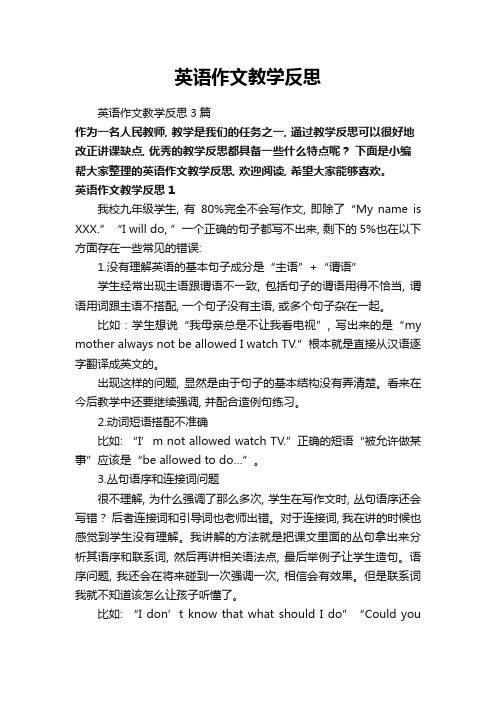
英语作文教学反思英语作文教学反思3篇作为一名人民教师, 教学是我们的任务之一, 通过教学反思可以很好地改正讲课缺点, 优秀的教学反思都具备一些什么特点呢?下面是小编帮大家整理的英语作文教学反思, 欢迎阅读, 希望大家能够喜欢。
英语作文教学反思1我校九年级学生, 有80%完全不会写作文, 即除了“My name is XXX.”“I will do, ”一个正确的句子都写不出来, 剩下的5%也在以下方面存在一些常见的错误:1.没有理解英语的基本句子成分是“主语”+“谓语”学生经常出现主语跟谓语不一致, 包括句子的谓语用得不恰当, 谓语用词跟主语不搭配, 一个句子没有主语, 或多个句子杂在一起。
比如:学生想说“我母亲总是不让我看电视”, 写出来的是“my mother always not be allowed I watch TV.”根本就是直接从汉语逐字翻译成英文的。
出现这样的问题, 显然是由于句子的基本结构没有弄清楚。
看来在今后教学中还要继续强调, 并配合造例句练习。
2.动词短语搭配不准确比如: “I’m not allowed watch TV.”正确的短语“被允许做某事”应该是“be allowed to do…”。
3.丛句语序和连接词问题很不理解, 为什么强调了那么多次, 学生在写作文时, 丛句语序还会写错?后者连接词和引导词也老师出错。
对于连接词, 我在讲的时候也感觉到学生没有理解。
我讲解的方法就是把课文里面的丛句拿出来分析其语序和联系词, 然后再讲相关语法点, 最后举例子让学生造句。
语序问题, 我还会在将来碰到一次强调一次, 相信会有效果。
但是联系词我就不知道该怎么让孩子听懂了。
比如: “I don’t know that what should I do”“Could youplease tell me should I do?”正确的句子应该是“I don’t know what I should do.”“Could you please tell me what I should do?”.以上这些问题让我对如何增强学生作文表达能力有了一个不全面的思考。
初中英语作文课教案

初中英语作文课精品教案一、教学目标1. 知识目标:(1)能够运用所学词汇和句型进行写作。
(2)能够正确使用常用的连接词和过渡语。
(3)能够运用一定的写作策略。
2. 能力目标:(1)能够独立完成一篇完整的作文。
(2)能够对自己的作文进行修改和润色。
3. 情感目标:(1)培养学生的写作兴趣和自信心。
(2)培养学生的合作意识和团队精神。
二、教学重难点1. 教学重点:(1)运用所学词汇和句型进行写作。
(2)正确使用连接词和过渡语。
(3)运用写作策略。
2. 教学难点:(1)正确使用连接词和过渡语。
(2)运用写作策略。
三、教学方法1. 任务驱动法:通过完成具体的写作任务,激发学生的学习兴趣和动机。
2. 合作学习法:通过小组讨论和同伴评价,促进学生之间的互动和交流。
3. 反馈矫正法:通过教师的及时反馈,帮助学生发现和纠正作文中的错误。
四、教学过程1. 导入:通过图片或故事引导学生进入写作主题。
2. 讲解:讲解本次写作的任务和要求,引导学生明确写作目标。
3. 示范:教师示范写作过程,展示如何运用所学词汇和句型。
4. 练习:学生独立完成写作任务,教师巡回指导。
5. 展示:学生展示自己的作品,进行自评和互评。
6. 总结:教师对学生的作文进行点评,指出优点和不足,进行总结。
五、课后作业1. 根据本次写作任务,修改和完善自己的作文。
2. 收集常用的连接词和过渡语,进行分类和总结。
3. 思考如何运用写作策略,提高自己的写作水平。
六、教学评价1. 学生自评:学生对自己的作文进行自我评价,包括内容、语言和结构等方面。
2. 同伴评价:学生之间互相评价对方的作文,互相学习和借鉴。
3. 教师评价:教师对学生的作文进行评价,给予肯定和指导,提出改进意见。
七、教学反思1. 反思教学内容:是否全面覆盖了本次写作的任务和要求。
2. 反思教学方法:是否有效地帮助学生完成写作任务。
3. 反思教学效果:学生的写作水平是否有所提高,学生的学习兴趣是否增强。
七年级上册语文第二单元英语作文教案及反思
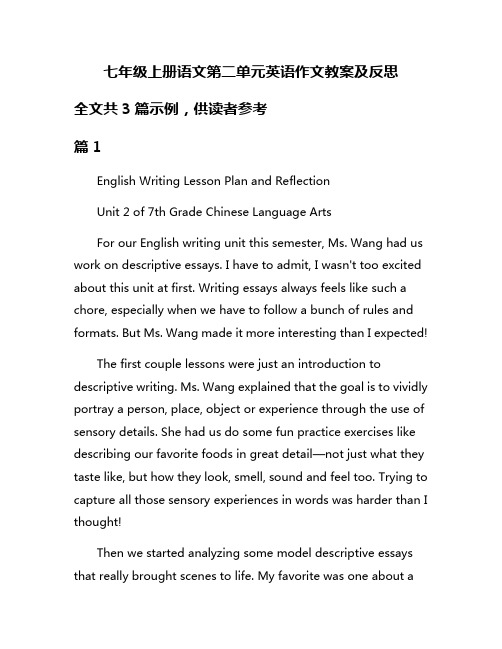
七年级上册语文第二单元英语作文教案及反思全文共3篇示例,供读者参考篇1English Writing Lesson Plan and ReflectionUnit 2 of 7th Grade Chinese Language ArtsFor our English writing unit this semester, Ms. Wang had us work on descriptive essays. I have to admit, I wasn't too excited about this unit at first. Writing essays always feels like such a chore, especially when we have to follow a bunch of rules and formats. But Ms. Wang made it more interesting than I expected!The first couple lessons were just an introduction to descriptive writing. Ms. Wang explained that the goal is to vividly portray a person, place, object or experience through the use of sensory details. She had us do some fun practice exercises like describing our favorite foods in great detail—not just what they taste like, but how they look, smell, sound and feel too. Trying to capture all those sensory experiences in words was harder than I thought!Then we started analyzing some model descriptive essays that really brought scenes to life. My favorite was one about asummer night at the beach. I could practically hear the crashing waves and smell the salty sea air as I read it. We highlighted all the techniques the author used like similes, metaphors, adjectives, and references to the five senses. Ms. Wang had us discuss why those techniques were so effective.Next up, we had to choose our own topic to write a descriptive essay about. I decided to write about my grandma's house since it's a place that feels really familiar and comforting to me. Ms. Wang had us freewrite descriptions of our topics for homework one night, just getting all our sensory impressions and memories down on paper. I filled up three whole pages describing the sights, sounds, smells and feeling of my grandma's house!The pre-writing was definitely the hardest part. Once I had all those raw impressions down, Ms. Wang taught us strategies for how to organize and structure a descriptive essay. We learned techniques like using an introduction that provides context, breaking things down into paragraphs focusing on different senses, and trying to build a sense of atmosphere. We also had to be mindful about using precise, vivid word choices.I have to admit, writing my first draft was tough. It's so hard to capture the feeling of a place in words! But Ms. Wang metwith me one-on-one during class and gave me lots of feedback on improving my details and descriptions. After a couple rounds of revisions where I really tried to dig deeper into the sights, smells, tastes and textures, I finally felt like my essay was vividly capturing the essence of my grandma's home.On the last day of the unit, a few students volunteered to read their final essays out loud. The one about a bustling city market was my favorite—I could practically see and hear all the action as she described it! And I was really proud to share my own essay about the cozy warmth and delicious smells of my grandma's kitchen.Overall, this descriptive writing unit ended up being a lot more rewarding than I expected. I'll admit I groaned a bit when Ms. Wang first assigned it, but working through the process of observing places through fresh eyes and translating that to vivid descriptive language was a valuable exercise. It really made me appreciate how writers can transport us to different worlds through their carefully chosen words and details.Writing the essay itself was definitely challenging, but thanks to Ms. Wang's guidance and the pre-writing exercises, I think my final draft captured the comforting ambiance of my grandma's home much more effectively than I could have at the beginning.Doing multiple drafts and really taking the time to choose vivid sensory details made a huge difference.I can definitely see the benefits of practicing descriptive writing skills. Bringing settings and experiences to life through vivid language seems like a useful writing technique for all kinds of essays, stories and other applications. Being able to focus on details and paint pictures with words is good practice for becoming a stronger writer in general.While writing a whole descriptive essay from scratch was tough, the process helped me develop useful observation, brainstorming and revision strategies. Having to really stop and take notice of all the sensory details around me was great practice for descriptive writing, but it also made me appreciate the richness of my everyday experiences more. And getting feedback from Ms. Wang on strengthening my word choices, organizational structure and descriptive techniques helped me level up my overall writing abilities.So while it wasn't the most naturally exciting unit to me at first, I'm really glad we spent some focused time on descriptive writing skills. With more practice, I can become better at transporting readers directly into the scene I'm describing, whether it's through a complete descriptive essay or just usingmore vivid details in other types of writing. Thanks to Ms. Wang's engaging lessons and hands-on practice, descriptive writing won't seem like such a chore for me anymore. I know it's a valuable technique that can make my words jump off the page.篇2Unit 2: English Writing - Lesson Plan and ReflectionFor our second unit in 7th grade English this year, we focused on developing our writing skills in English. Over the course of six weeks, we learned various strategies for planning, drafting, revising, and editing different types of essays and creative writing pieces. Here is an overview of what we covered each week and the activities we did, followed by my personal reflection on the unit.Week 1: Introduction to Essay WritingIn the first week, our teacher Ms. Roberts went over the fundamental structure of a five-paragraph essay. We learned about crafting a clear thesis statement, using topic sentences to organize body paragraphs, and writing effective introductions and conclusions. As a warm-up activity, we had to write a short opinion essay stating whether we preferred books or movies.This helped us immediately put the essay formatting into practice.Week 2: Persuasive EssaysThe next week, we dove deeper into persuasive writing techniques. We analyzed examples of persuasive essays and learned how to build a strong argument using credible evidence from reliable sources. Our main assignment was to write a persuasive essay convincing the school administration to make a policy change of our choice. I wrote mine about why our school should switch to a four-day week schedule. Gathering facts and expert opinions to support my argument was challenging but also taught me valuable research skills.Week 3: Narrative WritingFor our creative writing segment, we studied how to engage readers through vivid storytelling and descriptive details. We did some fun exercises like describing our favorite meal in great detail to practice using sensory language. The big assignment was to write a short fictional narrative story incorporating dialogue and using techniques like foreshadowing and symbolism. I really enjoyed the freedom of creative expression for this one!Week 4: Peer Review and RevisionWe didn't start any new writing this week. Instead, we focused on the revision process by peer reviewing each other's persuasive and narrative pieces. We learned how to provide constructive feedback and implement suggestions to improve our own drafts. It was immensely helpful to get a fresh perspective from my classmates.Week 5: The Literary Analysis EssayLiterary analysis was probably the most difficult writing mode we tackled. We had to deeply analyze a piece of literature, develop an original interpretation, and build an argument around that thesis using quotes and examples from the text as evidence. My essay analyzed the use of symbolism and motifs in the short story "The Cask of Amontillado" by Edgar Allan Poe. It took multiple drafts and a lot of critical thinking to produce a polished literary analysis.Week 6: Reflection and Final PortfolioIn our final week, we compiled all of our writing pieces from the unit into a portfolio. We also had to write a self-reflection evaluating our growth and areas for continued improvement as English writers. On the last day, a few students volunteered toread excerpts from their best works. It was really cool to see the creativity and diverse perspectives across the class.Overall Reflection:This writing unit was incredibly valuable for strengthening my skills across different modes and genres. I feel much more confident in my ability to craft a cohesive, well-supported essay compared to the beginning of the year. Practicing persuasive writing in particular helped me think more critically about developing and backing up my arguments.My favorite part was the creative narrative writing. I loved tapping into my imagination and felt liberated from some of the stricter conventions of academic essays. That said, I still found literary analysis to be the most challenging and will need to keep working on providing more insightful interpretations.The peer review process was so useful for getting helpful feedback. It pushed me to be more receptive to constructive criticism and make meaningful revisions to improve my writing. In the future, I want to get even better at giving detailed suggestions to my peers.I'm really proud of the progress I made and the pieces I produced over this unit. Moving forward, I know I need tocontinue expanding my vocabulary and varying my sentence structures to elevate my writing even further. I'm excited to build on these skills next semester and become a stronger, more sophisticated writer overall. Thank you Ms. Roberts for an awesome unit!篇3Unit 2: Essay Writing in EnglishLesson Objectives:Analyze the structure and elements of a 5-paragraph essayPractice writing clear topic sentences, body paragraphs, and conclusionsLearn techniques for writing engaging introductions and concluding paragraphsDevelop skills in revising and editing essaysWeek 1: The 5-Paragraph Essay StructureOur teacher started the unit by explaining the basic format for a 5-paragraph essay. She broke it down into the introduction paragraph, 3 body paragraphs, and the conclusion paragraph. We looked at examples and identified the key components like the hook, thesis statement, topic sentences, supporting details,and closing thoughts. Then we had to outline a sample essay by filling in those elements. It was a bit formulaic but helped cement the overall structure.Week 2: Writing IntroductionsThis week focused on crafting an engaging introductory paragraph. Our teacher showed examples of different hook strategies like questions, quotes, anecdotes, statistics, etc. We practiced writing several introduction paragraph examples using various hooks and thesis statements. My favorite was using a thought-provoking question to draw the reader in. It was challenging to write a really attention-grabbing opener.Week 3: Body ParagraphsNow it was time to drill down into the 3 body paragraphs that form the meat of the essay. We learned techniques for writing clear topic sentences that identify the main idea of each paragraph. Then we looked at ways to expand on the topic with specific examples, facts, explanations and other supporting details. The teacher emphasized the importance of using transition words, maintaining a logical paragraph flow, and not drifting off-topic. We spent a lot of time writing practice body paragraphs on different topics.Week 4: ConclusionsIn the final week, we focused on how to write an effective conclusion paragraph. We learned different strategies like restating the main points, making a call to action, ending with a thought-provoking question, or finishing with an impactful final statement. The conclusion should neatly wrap up the essay while also leaving a lasting impression on the reader. We practiced writing several conclusion examples and giving feedback to one another.Overall, this unit broke down the daunting task of essay writing into manageable steps. While the 5-paragraph format is somewhat rigid, it provided a solid foundation for constructing a coherent argument with an intro, body, and conclusion. Of course, the hardest part was actually putting pen to paper (or fingers to keyboard) and getting our thoughts to flow logically and eloquently. Revising and editing our rough drafts was crucial.I definitely feel more prepared to tackle essays after this unit, though I still have much to learn when it comes to expressing myself clearly and engagingly in written English.Some takeaways:The 5-paragraph format is a useful starting template, but essays don't always have to conform perfectly to that structure as I progress.Introductions and conclusions are pivotal - they leave the first and last impression, so spending extra time crafting them is worthwhile.Supporting claims with relevant evidence and explanations is key to a persuasive, substantive essay.The writing process involves multiple drafts of revising, reworking and polishing my work.Peer editing and feedback is valuable to refine my writing.This unit helped bolster my foundational essay writing abilities in English. However, I know I still have much room for growth when it comes to sophistication of ideas, fluency, and overall written expression. Writing remains daunting, but breaking it into systematic steps makes the process more manageable. With continued practice and a willingness to learn, I'm hopeful my English essay writing skills will continue to improve over time. I'm grateful for the strategies imparted in this unit.。
初三英语写作教学反思(精选3篇)

初三英语写作教学反思(精选3篇)初三英语写作教学反思1 一、写作是书面表达和传递信息的交际能力。
培养初步写作的能力,是英语教学的目的之一。
写作教学是初中英语教学的基本要求,也是中考英语试题的重要组成部分。
写作能力又是中学英语教学培养学生的重要语言技能之一,是学习者英语综合运用语言能力的体现。
限于初中英语教学的难度和广度,英语作文教学的内容往往有编写对话、看图写画、文章改写、日记、信件、通知、请假条等写作方式。
二、初中英语写作教学策略的实施:1.激发兴趣,由浅入深、循序渐进词汇学习可以促进英语水平的提高。
英语词汇量的积累对学生来说是非常关键的。
充足的英语词汇量,才有可能为写作提供“可理解的输入”。
可在实际教学中却有许多学生一提作文就面露难色、心生畏惧,写出来的作文东拼西凑,言之无味,毫无情感可言。
那怎样才能让学生敢于写、乐于写,从写作中体会到作文的乐趣,享受到作文的喜悦呢?对初一学生来说,我们不妨尝试让他们在课堂上以游戏的形式做一些扩词练习。
由教师或学生提供若干个单词,让他们利用这些单词编成一段有意义的对话或合乎情理的故事。
兴趣是学习的动力。
及时准确地了解某一阶段学生写作水平的发展情况,可以使教师在教学过程中少走弯路,减少盲目性。
如可以给初一学生布置“自我介绍”“介绍家庭”或“介绍朋友”等内容的作文;给初二学生可以设计“假日计划“”给笔友的信”“家乡的四季”或一些看图作文等。
总之,教师要及时对学生提供针对性的指导,而学生也能够及时有效地调整自己的写作策略。
2.布置落实课后写作练习。
很多教师对课后写作练习重视不够,不是轻描淡写地一带而过,就是把它布置为课后练习。
教师批改时往往只强调语言的准确性,学生写作时也是应付了事,渐渐地课后写作练习就形同虚设。
因此要化被动为主动,充分调动学生的主观能动性。
首先,在课前让学生进行充分准备;然后在课堂上各抒己见进行讨论;再让他们“添枝加叶”,丰富提纲以形成短文;最后课后修改整理。
初三作文教案反思模板范文

初三作文教案反思模板范文英文回答:Lesson Reflection Template for Grade 9 Composition。
Pre-Lesson Reflection。
Objectives: What are the learning objectives for the lesson?Materials: What materials will be needed for the lesson?Procedure: What are the steps of the lesson?During-Lesson Reflection。
Student Engagement: How engaged were students in the lesson?Assessment: How did the lesson assess student learning?Differentiation: How did the lesson accommodate the needs of all learners?Post-Lesson Reflection。
Strengths: What were the strengths of the lesson?Areas for Improvement: What areas of the lesson could be improved?Follow-Up: What follow-up activities will be needed?中文回答:九年级作文教学反思模板范文。
课前反思。
教学目标,本节课将要实现的教学目标有哪些?教学资源,本节课将要使用的教学资源有哪些?教学流程,本节课的教学流程是怎样的?课中反思。
学生参与度,学生在课堂上的参与度如何?教学评价,本节课如何评价学生的学习成果?教学分化,本节课如何满足不同学习者的需求?课后反思。
优点,本节课的优点有哪些?改进之处,本节课还有哪些地方可以改进?后续活动,本节课后需要开展哪些后续活动?。
我教案反思模板英语作文
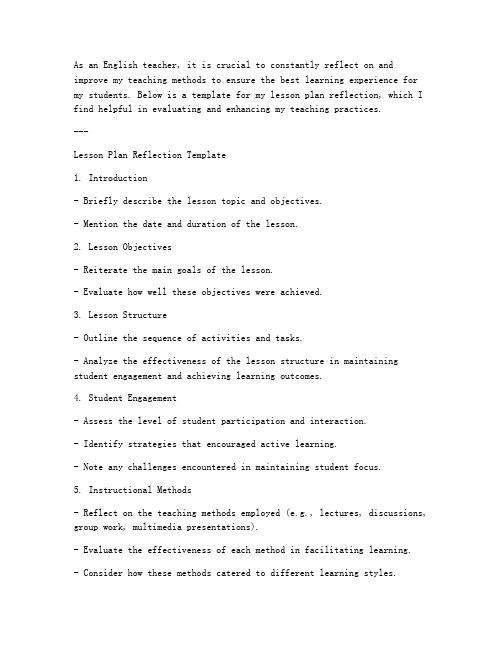
As an English teacher, it is crucial to constantly reflect on and improve my teaching methods to ensure the best learning experience for my students. Below is a template for my lesson plan reflection, which I find helpful in evaluating and enhancing my teaching practices.---Lesson Plan Reflection Template1. Introduction- Briefly describe the lesson topic and objectives.- Mention the date and duration of the lesson.2. Lesson Objectives- Reiterate the main goals of the lesson.- Evaluate how well these objectives were achieved.3. Lesson Structure- Outline the sequence of activities and tasks.- Analyze the effectiveness of the lesson structure in maintaining student engagement and achieving learning outcomes.4. Student Engagement- Assess the level of student participation and interaction.- Identify strategies that encouraged active learning.- Note any challenges encountered in maintaining student focus.5. Instructional Methods- Reflect on the teaching methods employed (e.g., lectures, discussions, group work, multimedia presentations).- Evaluate the effectiveness of each method in facilitating learning.- Consider how these methods catered to different learning styles.6. Assessment and Feedback- Describe the assessment methods used during the lesson (e.g., quizzes, oral presentations, peer evaluations).- Reflect on the accuracy and fairness of the assessments.- Discuss the feedback provided to students and its impact on their learning.7. Materials and Resources- Comment on the appropriateness and availability of teaching materials.- Assess the impact of technology and other resources on the lesson's success.8. Challenges and Solutions- Identify any challenges faced during the lesson (e.g., technical difficulties, student behavior).- Propose solutions or alternative strategies to address these challenges in the future.9. Student Learning Outcomes- Analyze the extent to which students met the lesson objectives.- Reflect on any gaps in understanding or knowledge that need to be addressed.10. Personal Reflection- Reflect on your own performance as a teacher.- Consider what you did well and what could be improved.- Note any personal learning or insights gained from the lesson.11. Recommendations for Future Lessons- Based on this reflection, suggest changes or modifications to the lesson plan for future teaching sessions.- Outline specific strategies to enhance student learning and engagement.12. Conclusion- Summarize the key points of the reflection.- Express your commitment to continuous improvement as an educator.---Using this template, I can systematically evaluate my teaching practices and make informed decisions to enhance the learning experience for my students. It helps me to identify areas for improvement, adapt my teaching methods, and ultimately become a more effective educator.。
初中英语作文教案反思模板
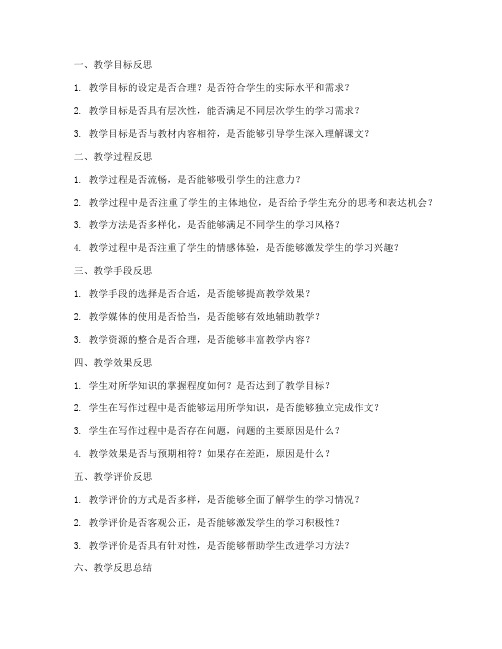
一、教学目标反思1. 教学目标的设定是否合理?是否符合学生的实际水平和需求?2. 教学目标是否具有层次性,能否满足不同层次学生的学习需求?3. 教学目标是否与教材内容相符,是否能够引导学生深入理解课文?二、教学过程反思1. 教学过程是否流畅,是否能够吸引学生的注意力?2. 教学过程中是否注重了学生的主体地位,是否给予学生充分的思考和表达机会?3. 教学方法是否多样化,是否能够满足不同学生的学习风格?4. 教学过程中是否注重了学生的情感体验,是否能够激发学生的学习兴趣?三、教学手段反思1. 教学手段的选择是否合适,是否能够提高教学效果?2. 教学媒体的使用是否恰当,是否能够有效地辅助教学?3. 教学资源的整合是否合理,是否能够丰富教学内容?四、教学效果反思1. 学生对所学知识的掌握程度如何?是否达到了教学目标?2. 学生在写作过程中是否能够运用所学知识,是否能够独立完成作文?3. 学生在写作过程中是否存在问题,问题的主要原因是什么?4. 教学效果是否与预期相符?如果存在差距,原因是什么?五、教学评价反思1. 教学评价的方式是否多样,是否能够全面了解学生的学习情况?2. 教学评价是否客观公正,是否能够激发学生的学习积极性?3. 教学评价是否具有针对性,是否能够帮助学生改进学习方法?六、教学反思总结1. 总结本次教学过程中的优点,为今后教学提供借鉴。
2. 分析教学过程中存在的问题,并提出改进措施。
3. 对教学效果进行评价,为今后教学提供参考。
4. 结合教学反思,不断调整教学策略,提高教学质量。
以下为具体反思内容:一、教学目标反思本次教学目标的设定较为合理,符合学生的实际水平和需求。
但在教学过程中,发现部分学生对于某些知识点掌握不牢固,说明教学目标还需进一步细化。
二、教学过程反思教学过程较为流畅,但部分环节仍需改进。
例如,在引导学生思考问题时,可以适当增加互动环节,提高学生的参与度。
三、教学手段反思教学手段的选择较为合适,但在实际操作中,部分教学媒体的使用效果不佳。
- 1、下载文档前请自行甄别文档内容的完整性,平台不提供额外的编辑、内容补充、找答案等附加服务。
- 2、"仅部分预览"的文档,不可在线预览部分如存在完整性等问题,可反馈申请退款(可完整预览的文档不适用该条件!)。
- 3、如文档侵犯您的权益,请联系客服反馈,我们会尽快为您处理(人工客服工作时间:9:00-18:30)。
初中英语作文教案
一、背景知识介绍。
书面表达是写的一种途径,是英语交际的重要组成部分。
初中阶段对于英语写作的要求,实际上是“有指导的写作”(Guided Writing)。
它通过提供情景(文字、图画、表格),让学生用学过的英语语言来描述事物或事件并表达一定的思想,以此达成和检验对所学英语语言知识的实践应用能力。
客观地说,书面表达一直是我们英语教学的一个难点,也是学生应试的一个难点。
从去年对中考英语试卷的抽样调查情况来看,英语写作是得分最为薄弱的一个题项,平均分只有4.7分(满分为12分)。
究其原因,一是学生写作练习的时间少,二是教师平时缺乏对学生进行系统的写作知识的指导。
(比如,如何用词、句、组段、谋篇等)。
这些原因造成了学生从最初不会写盲目写到不愿写。
惧怕写,直至最后拒绝写的恶性循环。
针对这一现象,我在教学过程进行了一次如何提高学生写作能力的课堂实践。
教师旨在通过与学生谈论他们熟悉的话题“making friends”, 搜索学生头脑中有关朋友的消息,通过阅读两则e-pal广告,获取e-pals的一些信息,指导如何写e-mail ,从而达到给e-pals 写信的目的。
二、教学过程。
1.Warm-up活动:通过听一首英语歌:“The more we get together, the happier we’ll be.”目的是活跃气氛,为引出今天的话题做准备。
2.Revision ①使用大脑风暴法(brainstorm)让学生想出一些和friends 有关的单词短语和句子,目的是激活学生头脑中和写作话题make friends 相关的东西,如想法、概念、形象等酝酿写作的思路,供拟稿阶段(drafting stage)选择有写的价值和意义的东西时参考。
] ①根据下列所给提示介绍你的朋友(四人一小组活动)。
①Name and age. ①Where he / she comes from subject? ①What he is? ①What his / her friend? ①looks(外貌)①personality(性格)①His / Her dream ①……3.Pre-reading 通过提问,How can you know your friends, if you haven’t seen each other for a long time? 联系朋友有很多方法,但是One of the best ways is sending e-mails to them. Do you know why?过渡今天话题的材料,快速看完两则e-pal广告,找出答案。
4.While-reading,读两则广告,了解Mary和Jack完成表格Name Age Hobbies
Looks Personality E-mail added Wish Where she…
5.Post-reading 引导学生讨论:Do you like to make e-pals with Mary or Jack? Why? 当大部分学生都持肯定观点时进一步思索,What will you write in you e-mail to them? 为下面事实写作埋下伏笔,提供铺垫。
6.While-Writing. 教会学生正确使用e-mail格式,同时提供关于朋友和友谊的一些精彩句子,为学生写作提供素材。
7.Post-writing. 提供写作标准
要求学生根据这个标准,修改自己的e-mail.
1. Do you use the tense (时态),spelling(拼写),punctuation (标点),capitalization( 大写字母)correctly?
2. I s your e-mail complete(完整的)?
3.Is your e-mail coherently(连贯地)written?
4.Can you describe yourself in a concise(简洁的)way?
5.Are there any
complex sentences(复合句)in your e-mail?
目的是通过自改,有助于他们提高书面表达中的语言准确性,提高了学生通过自己独立思考,来解决问题的能力。
8.Share the writing.
点评两篇学生习作,选自一位基础较好的同学和一位基础一般的同学的作文。
教师根据上述提供的写作标准,详细点评两篇习作的篇章结构和句法功能。
目的是使学生尽力领会教师对文章的点评,培养学生选词和用词的能力,指导学生多模仿好文章的优点。
三、本堂课中的精彩片段。
就整节课而言,这无疑是一堂令人喝彩的课,无论是从学生参与课堂实践的积极性来看,还是从学生出色完成教师布置的任务后而展示的成果来看,都给听课的老师留下了一种意犹未尽的印象。
而我自己觉得其中有两个精彩片段更值得与同行们分享。
①使用brainstorming培养学生在英语写作中自主学习的能力。
Brainstorming 这种外语教学中常用的教学技巧可直评为“头脑风暴法”是一种通过小型会议的组织形式,让所有参加者在自由、愉快、畅所欲言的气氛中自由交换观点,并以此诱发集体智慧,激发学习者创意与灵感的学习方法。
在英语课中。
